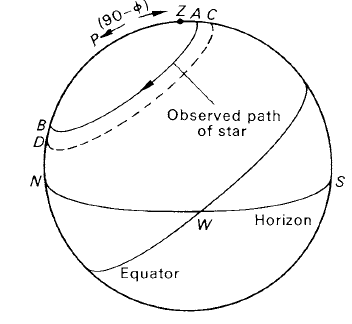
Atmospheric refraction: Measurement of the constant of refraction
 المؤلف:
A. Roy, D. Clarke
المؤلف:
A. Roy, D. Clarke
 المصدر:
Astronomy - Principles and Practice 4th ed
المصدر:
Astronomy - Principles and Practice 4th ed
 الجزء والصفحة:
p 116
الجزء والصفحة:
p 116
 30-7-2020
30-7-2020
 1912
1912
Atmospheric refraction: Measurement of the constant of refraction
The constant of refraction, k, may be measured by using the transits of a circumpolar star. It has been seen that the effect of refraction is to displace the star towards the zenith along the vertical through star and zenith. Thus, in figure 1, an observer in latitude φ notes that a star has upper and lower culminations at A and B respectively. Let the observed zenith distances of A and B be ζA and ζB respectively. In the absence of refraction, the upper and lower transits would have been seen to be at positions C and D on the celestial sphere, where PC = PD = 90 − δ, δ being the star’s declination.
Note: if the declination of the star was such that the upper transit had been north of the zenith, the observed path of the star would have intersected the parallel of declination it would have followed in the absence of refraction.

Figure 1. Measurement of an angle of refraction.
R = k tan ζ........(1)
Now by equation (1),
CA = k tan ζA DB = k tan ζB
so that we have
ZC = ζA + k tan ζA ZD = ζB + k tan ζB.
But
ZC = PC − PZ = 90 − δ − (90 − ∅) = ∅ − δ.
Hence,
∅ − δ = ζA + k tan ζA.......... (2)
Similarly,
ZD = ZP + PD = 90 − ∅ + 90 − δ = 180 − ∅ − δ
so that
180 − ∅ − δ = ζB + k tan ζB.......... (3)
If the observer’s latitude were accurately known, the two equations (2) and (3) in the two unknowns δ and k could be solved to yield values of δ and k. But because of small changes in the Earth’s crust, small variations take place in the latitude of the telescope used. In practice, therefore, at least two circumpolar stars are observed, within a short period of time, so that two more equations are obtained, namely
 ........(4)
........(4)
 ...........(5)
...........(5)
The four equations (2)–(5) are now solved to give values of δ, δ', ∅ and k.
 الاكثر قراءة في مواضيع عامة في علم الفلك
الاكثر قراءة في مواضيع عامة في علم الفلك
 اخر الاخبار
اخر الاخبار
اخبار العتبة العباسية المقدسة


